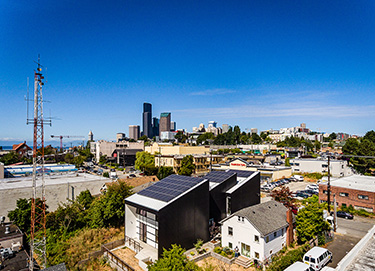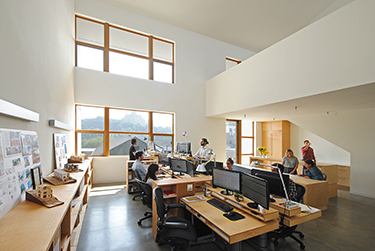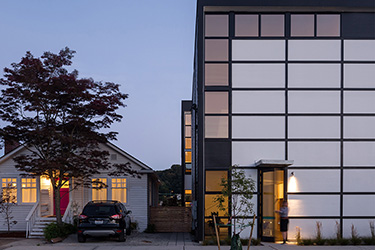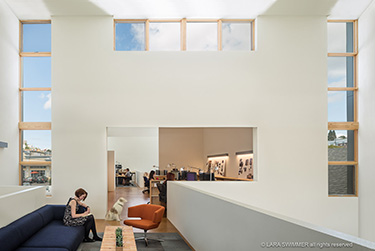|
Subscribe / Renew |
|
|
Contact Us |
|
| ► Subscribe to our Free Weekly Newsletter | |
| home | Welcome, sign in or click here to subscribe. | login |
Construction
| |
 |
March 29, 2018
We designed our own net-zero office — and you can, too
JW Architects

Weber
|

Walker
|
Why does your building still use energy? Ours doesn’t. Yours doesn’t have to, either.
Seattle is recognized as a leader in sustainability, with groundbreaking architecture such as the Bullitt Center. The business success in Seattle has led to thousands of people moving to the city each year.
Our day-to-day work focuses on creating urban infill housing for the people living here. We work to provide higher-density living, which results in a lower carbon footprint.
JW Architects was founded in a garage in 2009 and then moved into two offices in a historic building in Columbia City. In 2014, we had the opportunity to design our new office building. We translated our experience with high-performance-energy homes into a high-performance-energy office space.
Today, we work in a zero-energy building certified by International Living Future Institute. Three years ago, we never would have thought this was possible. It surprised us at how achievable it was with hard work, collaboration, a little bit of scrappiness and a lot of passion.
Zero-energy certified
It is not hard to find someone in Seattle who wants to make an impact on climate change. We harnessed that energy in our young office, set the ambitious goal of achieving zero energy, and came together to make it happen.
We began designing the building in 2014, broke ground in August 2015 and moved in the following June.
In the midst of the design process, some staff members attended 16 hours of continuing education classes offered by the American Institute of Architects about “getting to zero.” The case studies presented were inspiring and intriguing, but with the Bullitt Center as the only certified zero-energy office space at the time, achieving zero energy seemed like a lofty goal. However, we researched and thought about which certification best represented the direction the firm was headed.
The distinction of zero energy ended up being the best choice. Zero energy has a succinct definition: “In one year, our building produces more energy than it uses.”
We enjoy telling this to friends and colleagues because it's clear and people can easily identify with the measurement and values.
Zero-energy certification by International Living Future Institute requires one year of proven performance. We achieved that in September 2017 after occupying the building for 15 months. Our office on King Street is the second commercial building in Seattle to be certified, following the Bullitt Center.
Since occupying the building, we have spent time reflecting on the strategies used and some key lessons learned.
Design strategies
• Upgrading the building envelope. We drew on our knowledge base and created an energy model in-house. We calculated the most strategic insulation strategies and placed R-20 rigid insulation below the slab, and 2 inches of spray foam on the walls for both insulation and air infiltration.
The remainder of the 2-by-8-inch exterior wall is filled out with blown-in fiberglass insulation. The roof is underlain by CertainTeed MemBrain and insulated with two rolls of R-38 insulation and covered with a white metal roof to minimize heat gain.
• High-efficiency mechanical. Two air-to-air heat pumps provide both heating and cooling with distribution by two high air-handling units dedicated to each zone.
Indoor air is exchanged with outdoor air by a heat-recovery ventilation system. Hot water for bike and run commuters is provided by a heat pump hot water heater. We use an all-LED lighting system.
• Daylighting. At King Street, the outdoors can be experienced inside with great views of Mount Rainier on clear days. We implemented a time-tested sawtooth roof form with north-facing windows to create a balanced quality of daylighting, reducing our energy load over the year.
• Measuring plug loads. Plug loads were measured by using two $90 electricity consumption meters and creating a spreadsheet. We plugged the meter into each electrical device in the Columbia City office and measured the usage for two weeks.
Many offices that pursue zero-energy usage convert all their computing to laptops. We experimented with that, but found the reduced screen size challenging. We upgraded our desktop spec to include the most efficient CPUs and graphics cards.
Lessons learned
• Rate of heating and cooling. The building cools down efficiently from the passive ventilation strategy of night flushing. When the heat pump is producing cool air, the building gets comfortable very quickly because of the natural stratification of the air. The large volume of the interior keeps the building from getting comfortable as fast when heating.
• Daylighting. We used much less artificial lighting than expected. The energy model was based on operating our all-LED system for a building-wide average of 11 hours per day for 250 days per year.
At our office, people have individual LED task lamps they typically use for a couple hours in the early morning and later afternoon. Daylighting is the primary source of lighting even on the grayest of days.
Though our projected EUI was 20.4, our actual EUI was 17.4 after 12 months of occupancy. We attribute that to the amount of useful daylighting and limited use of artificial lighting.
• Visibility of the solar panels. Clients typically push us to make sure the solar panels are visible to the homeowner. After touring friends and family through the building, we wish the panels were more visible from inside the building.
• Night flushing. Our team was engaged with the building while experimenting with night flushing strategies. Through trial and error, we eventually achieved a strategy that is successful.
• Learning to be an intentional occupant. We are diligent about opening windows and turning on and off the heat. In the winter, we run the heat from 7:30-8:15 a.m. and then supplement throughout the day when needed. We do not have to sacrifice comfort to achieve zero energy.
New projects
Our whole team has a stake in this one statement:"In one year, our building produces more energy than it uses."
Energy conservation is embedded in our office culture and everyone contributes. Currently, we are applying many of the lessons learned from the King Street office to two residential projects targeting zero-energy certification. In the works are a compact seven-unit rowhouse project in Ballard and a single-family home in Georgetown.
We will continue pushing forward on designing for lasting sustainability through zero-energy strategies.
Julian Weber is the founding principal of JW Architects. Emily Walker is the client relations manager.
Other Stories:
- Let’s make buildings people can still use after a disaster
- New green rating systems go way beyond LEED
- How cleaner indoor air makes for healthy workers and a healthier bottom line
- Cheap solar energy won't end the need for deep-green buildings
- To meet green goals, cities must grow more strategically
- Asphalt: the go-to material for green paving projects
- Climate change is making resilience a more urgent design priority
- SPU remodel shows even industrial buildings can be green
- Why we can’t reach our emissions goals without tracking embodied carbon






